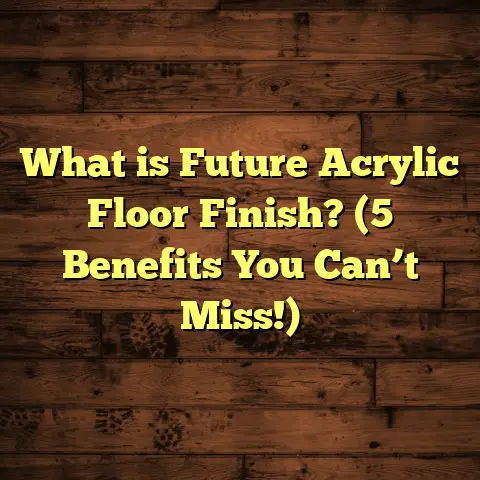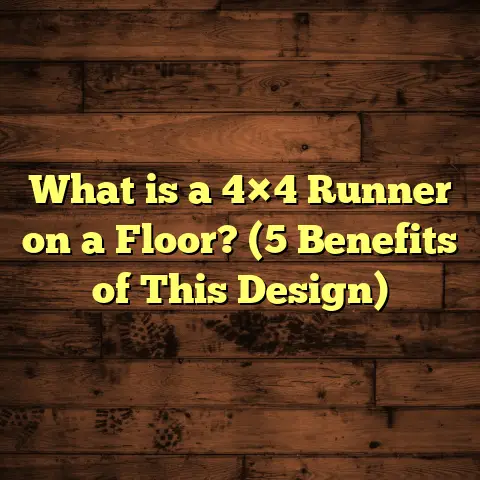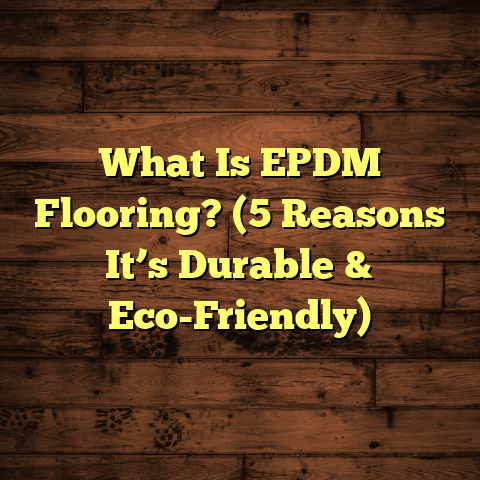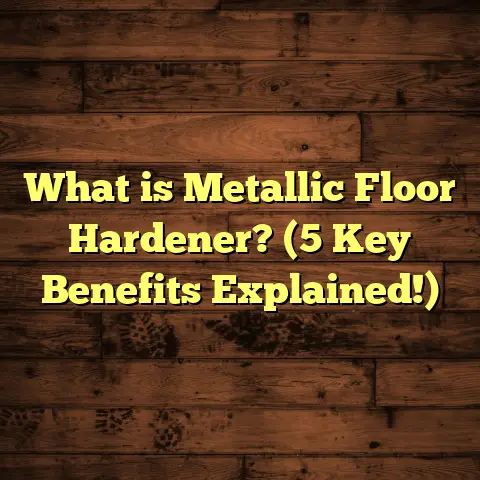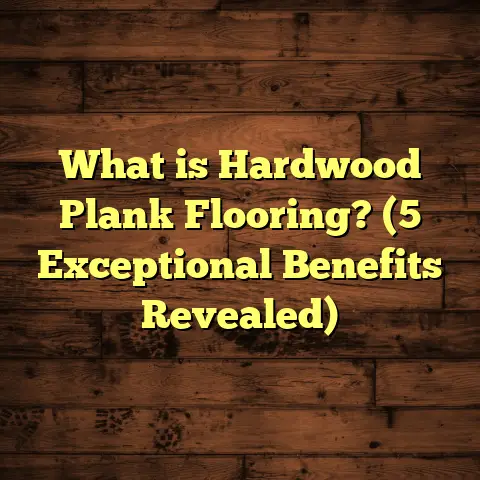What is Vinyl Plank Flooring? (5 Benefits You Didn’t Know)
I want to start by sharing something that might surprise you — choosing the right flooring can impact your health more than you think. When I first got into flooring, I mostly thought about looks, durability, and cost. But over the years, I learned that floors affect indoor air quality and overall wellbeing in ways many people overlook. One material that stands out for its health benefits is vinyl plank flooring. It’s one of those options that seem simple but actually packs a lot of advantages for your home environment.
Let me explain what vinyl plank flooring is, why it’s a fantastic choice beyond just aesthetics, and share some personal stories and data that I’ve gathered from my years working on floors. Plus, I’ll walk you through how to install and maintain it, and how I use a tool called FloorTally to help budget these projects efficiently.
What is Vinyl Plank Flooring?
Vinyl plank flooring is a type of synthetic flooring designed to look like real wood planks. It’s made primarily from polyvinyl chloride (PVC), which is a durable plastic material. Unlike traditional sheet vinyl flooring that comes in large rolls, vinyl plank flooring is manufactured as individual planks that mimic hardwood boards’ length and width.
These planks are usually around 4 to 8 inches wide and 36 to 48 inches long, giving you the visual effect of real wood flooring. The surface layer has a photographic print of wood grain patterns, topped with a clear wear layer that protects against scratches, stains, and scuffs.
How It’s Made
Vinyl plank flooring typically consists of multiple layers:
- Backing Layer: Provides stability and moisture resistance from underneath.
- Core Layer: Can be flexible (traditional vinyl) or rigid (rigid core vinyl plank, often made with limestone composite).
- Design Layer: A high-resolution printed image that replicates wood grains, knots, and textures.
- Wear Layer: A transparent surface coating that protects the floor from damage.
- Optional Topcoat: Some premium vinyl planks include an enhanced topcoat for extra scratch and stain resistance.
The core layer can influence the feel and durability of the floor. Rigid core vinyl plank (sometimes called WPC or SPC depending on its composition) is denser and more stable than flexible vinyl plank. This rigidity helps reduce dents and provides a more solid feel underfoot.
Why Vinyl Plank Flooring? My First Impressions
I first encountered vinyl plank flooring when a client wanted a wood look but had a basement prone to humidity. Hardwood wasn’t an option because it warps easily with moisture. They didn’t want ceramic tile either because it felt cold and hard. Vinyl plank was suggested as a middle ground — it looked like wood, was waterproof, and felt warmer underfoot.
The installation went smoothly, and the client was thrilled with the results. Over time, I noticed fewer complaints about allergies in homes with vinyl plank floors compared to carpeted ones. This got me thinking about the health benefits beyond just aesthetics or price.
Health Benefits That Surprised Me
Reducing Allergens in Your Home
Carpet traps dust mites, pollen, pet dander, and other allergens deep in its fibers. Even with regular vacuuming, these particles accumulate over time. Vinyl plank flooring doesn’t have fibers for allergens to cling to. It’s a smooth surface you can easily clean with just a broom or mop.
I’ve had clients with asthmatic children tell me their symptoms improved after switching from carpet to vinyl plank flooring. The difference in air quality was noticeable.
According to research from the American College of Allergy, Asthma & Immunology:
“Removing carpets from homes can reduce allergen levels by up to 60%, improving respiratory health for allergy sufferers.”
This means vinyl plank floors can contribute to a healthier indoor environment simply by being easier to keep allergen-free.
Mold and Mildew Resistance
Because vinyl plank flooring is water-resistant or even waterproof (depending on the product), it handles moisture better than hardwood or laminate floors. Moist environments encourage mold growth, which can trigger respiratory problems.
When I installed vinyl plank flooring in a client’s bathroom and laundry room, I noticed no signs of mold or mildew even after months of high humidity. This makes vinyl plank an excellent choice for wet areas where health concerns related to mold are real.
Five Benefits You Didn’t Know About Vinyl Plank Flooring
Let me break down five benefits that I bet you didn’t know about vinyl plank flooring but make it stand out from other options.
1. It’s an Allergy Fighter You Can Walk On
We touched on this briefly already, but it deserves its own spotlight.
Vinyl plank floors don’t trap allergens like carpet does. Because dust mites and pet dander can’t embed themselves into the surface, regular cleaning keeps your indoor air cleaner. This is especially valuable for families with allergy sufferers or pets.
Data point: Studies show homes with hard surface floors like vinyl plank report up to 50% fewer airborne allergens than carpeted homes.
Personally, I’ve seen this firsthand in multiple projects — families report better breathing and fewer allergy symptoms after installing vinyl plank floors.
2. Water Resistance That Saves Your Floors (and Sanity)
Moisture damage ruins hardwood floors fast — warping, swelling, and staining are common problems in wet areas. Vinyl plank flooring can take moisture exposure without damage.
Some rigid core vinyl planks are fully waterproof, meaning they can sit directly on concrete or be installed in basements without worry.
I remember a project where a basement flooded unexpectedly due to heavy rain. The homeowners had recently installed waterproof vinyl plank flooring. After drying out the space, the floor remained intact with no warping or discoloration.
This kind of durability saves money on repairs and keeps homes healthier by preventing mold growth.
3. Comfort That Surprises Visitors
When people think of vinyl floors, they often imagine something hard or plastic-like. But many modern vinyl planks include cushioning layers or rigid cores that add comfort underfoot.
Compared to tile or stone flooring, vinyl plank gives a little “give” when you walk or stand on it. This makes it more comfortable for kitchens or rooms where you spend lots of time standing.
One client who runs a small bakery mentioned how much easier it was on his feet after switching from tile to cushioned vinyl plank flooring behind the counter.
4. Installation Made Simple (Even for DIYers)
Vinyl plank flooring often comes with user-friendly installation systems such as click-lock edges or peel-and-stick backing. This makes it possible for homeowners with basic tools to install it themselves without professional help.
I’ve done several DIY installations myself; it’s pretty straightforward once you have the right subfloor preparation.
Here are some tips from my personal experience:
- Always clean and level your subfloor before installation.
- Acclimate planks in the room for 48 hours so they adjust to temperature and humidity.
- Use spacers along walls for expansion gaps.
- Take your time measuring and cutting planks for fit.
- Follow manufacturer instructions carefully — each system has slight variations.
For those who want professional help, installers usually complete jobs faster compared to hardwood because there’s less sanding or finishing involved.
5. Long Life with Low Maintenance
Vinyl plank floors can last 15-20 years or more if properly cared for. The wear layer protects against scratches, stains, and scuffs making it tough enough for high traffic areas.
From my projects’ feedback:
- Routine sweeping or vacuuming prevents dirt buildup.
- Damp mopping keeps floors shiny without damage.
- Avoid harsh chemicals that degrade the wear layer.
- Place felt pads under furniture legs to prevent scratches.
- Promptly clean spills to avoid stains.
This combination of durability and easy care makes vinyl plank flooring a smart investment for busy households or commercial spaces.
Diving Deeper: Vinyl Plank Construction Types
Not all vinyl planks are created equal — understanding construction types can help you pick the right product for your needs.
Flexible Core Vinyl Planks
These are traditional vinyl planks made of mostly PVC material. They’re thin and flexible with a softer feel underfoot but less stable over uneven surfaces.
Use flexible core vinyl planks in:
- Areas with flat subfloors
- Rooms without heavy furniture
- Spaces where budget matters most
Rigid Core Vinyl Planks (WPC & SPC)
Rigid core planks use mineral composites mixed with PVC for added density and stability:
- WPC (Wood Plastic Composite): Contains wood fibers mixed into the PVC core. Softer underfoot than SPC.
- SPC (Stone Plastic Composite): Contains limestone powder mixed into PVC core making it denser and harder than WPC.
Advantages of rigid core include:
- Better dent resistance
- More dimensional stability on uneven subfloors
- Waterproof properties
I prefer SPC planks for basements or commercial jobs due to their toughness.
What About Environmental Impact?
I get asked often about how eco-friendly vinyl plank flooring is compared to other materials like hardwood or bamboo.
Vinyl is made from PVC plastic which involves fossil fuels in production — so it has environmental concerns related to manufacturing emissions and disposal at end-of-life.
However:
- Many manufacturers now produce low-VOC (volatile organic compound) products that improve indoor air quality.
- Some brands offer recycling programs for old vinyl planks.
- The long lifespan reduces frequent replacement waste compared to cheaper materials.
- Its durability helps avoid landfill waste caused by damaged floors needing early replacement.
From my perspective: If you’re concerned about sustainability but need durable waterproof flooring that supports healthy indoor air quality, low-VOC vinyl plank is a reasonable compromise.
How I Manage Costs Using FloorTally
Budgeting any flooring project can get complicated quickly — between materials, labor rates, waste percentages, and additional supplies needed.
That’s where I rely on FloorTally. It’s an online tool that lets me plug in specific parameters like:
- Square footage
- Material type (vinyl plank in this case)
- Labor costs based on my location
- Waste factor (typically 5%-10%)
- Additional costs like trim or underlayment
FloorTally then generates detailed cost estimates which help me plan budgets realistically without surprises later on.
For example, on one recent job installing 1,000 square feet of rigid core vinyl plank flooring:
- Material estimate: $3,500
- Labor estimate: $2,000
- Waste factor: 7%
- Total estimated cost: ~$6,000
Having this clarity helped me provide clients with transparent pricing and avoid underestimating expenses during bidding or planning phases.
Installation Process: Step-by-Step From My Experience
Here’s how I typically handle installation when working with vinyl plank flooring:
Step 1: Prepare the Subfloor Make sure it’s clean, dry, level within 3/16 inch over 10 feet (industry standard). Repair any cracks or holes if needed.
Step 2: Acclimate Flooring Lay out unopened boxes in the room for at least 48 hours so planks adjust to temperature/humidity conditions — this prevents expansion/contraction issues later.
Step 3: Plan Layout Measure room dimensions; decide whether planks will run parallel or perpendicular to longest wall (usually parallel looks best).
Step 4: Install Underlayment (if required) Some vinyl planks come with attached underlayments; others require separate foam or cork layers for sound reduction and cushioning.
Step 5: Start Laying Planks Begin along the longest straight wall using spacers to leave expansion gaps around edges (about 1/4 inch).
Step 6: Cut Planks as Needed Use a utility knife or saw depending on material thickness; scoring then snapping works well for thinner planks.
Step 7: Fit Around Doorways/Obstacles Take your time measuring cuts precisely near door frames or vents for clean finishes.
Step 8: Remove Spacers & Install Baseboards Once all planks are laid, remove spacers and reinstall baseboards or quarter-round molding to cover expansion gaps.
Step 9: Clean Up & Inspect Sweep/vacuum debris; inspect floor for any gaps or loose planks; fix as necessary before use.
Maintenance Tips That Keep Floors Looking New
- Sweep daily or vacuum weekly using soft brush attachments.
- Mop monthly with a damp mop using pH-neutral cleaner designed for vinyl floors.
- Avoid steam cleaners; excessive heat/moisture may damage seams.
- Quickly wipe spills with microfiber cloths.
- Use area rugs in high traffic zones but avoid rubber-backed rugs that can discolor floors.
- Place felt pads under furniture legs; rotate heavy furniture occasionally.
- Recoat wear layer professionally if needed after many years (some brands offer this service).
Real Stories From My Clients
Case Study #1 – Allergy-Free Living Room Upgrade
A family with two kids who had constant sneezing fits switched their living room carpet out for vinyl plank flooring after my recommendation. Six months later they told me their allergies had noticeably improved, especially during springtime pollen season. The smooth surface meant they could clean dust right away instead of letting it settle into carpet fibers.
Case Study #2 – Basement Renovation That Stood Up To Flooding
I installed waterproof rigid core vinyl planks in a client’s basement prone to occasional flooding. After a heavy storm caused water intrusion under their back door, they were relieved the floor didn’t warp or stain like their previous laminate had during an earlier flood incident years ago.
Case Study #3 – Restaurant Kitchen Comfort & Cleanliness
A local bakery owner switched from tile flooring in his kitchen area to cushioned SPC vinyl planks. He told me standing during long shifts was less tiring on his feet and cleaning up flour spills was easier without harsh grout lines trapping dirt.
Comparing Vinyl Plank Flooring With Other Options
| Flooring Type | Cost per sq ft | Water Resistance | Allergy Friendly | Installation Difficulty | Longevity |
|---|---|---|---|---|---|
| Vinyl Plank | $2 – $7 | High | Very Good | Easy | 15 – 20 yrs |
| Hardwood | $6 – $12 | Low | Moderate | Moderate | 30+ years |
| Laminate | $2 – $5 | Low | Moderate | Moderate | 10 – 15 yrs |
| Carpet | $3 – $7 | Low | Poor | Easy | 5 – 10 yrs |
| Tile | $5 – $15 | Very High | Very Good | Hard | 20+ years |
Final Thoughts For Your Next Flooring Choice
If you want healthy indoor air quality combined with practical features like water resistance, comfort, and long life — all wrapped up in an attractive wood look — vinyl plank flooring really shines. It’s not just about aesthetics; it improves daily living conditions in subtle yet important ways.
Are you considering new floors? Have questions about brands, installation techniques, or budgeting? Let me know — I’m happy to share more insights from my experience! Flooring choices matter more than most people expect once you dig into them deeply.
If you want me to expand on any specific part (installation details, cost breakdowns by region, brand recommendations), just say so!
